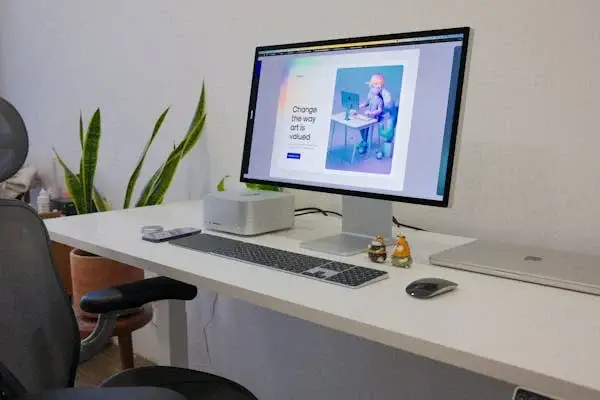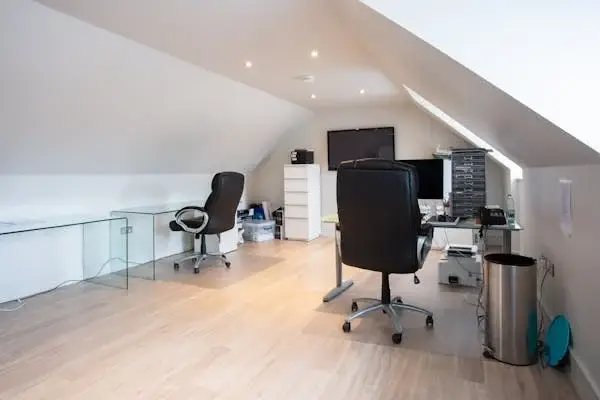Table of Contents
ToggleMaximize Efficiency with Ergonomic Office Furniture: 7 Powerful Ways to Boost Productivity and Comfort
Endurance at Work – Using Ergonomic Office Furniture
For office furniture, comfort is key — but so is productivity. The right ergonomic office furniture not only makes your working area comfortable but can also significantly increase your efficiency and your overall health. If you want to be more efficient with your ergonomic office furniture, you are in the right place! The following article will cover why ergonomics are essential in the workplace. Read about it and learn how investing in ergonomic furniture can change your office space.
Comfort, health, and productivity have a strong correlation: A well-designed ergonomic workspace can enhance employee attention, mitigate discomfort, and stave off chronic illnesses in the long term. Whether outfitting a home office or an entire team, the right ergonomic solutions will help you create a productive and supportive environment. Making ergonomics a priority is imperative to not only the productivity of your workspace but also your overall health because you want to work harder and brighter.
In the following sections, we will explore the various elements of ergonomic office furniture in more detail, helping you create an efficient setup that maximizes productivity.
Why Ergonomics Matter in the Workplace

What Is Ergonomics When It Comes to Office Furniture?
Ergonomics uses data regarding a user’s needs to create workspaces and tools that encourage comfort and efficiency. Ergonomic office furniture refers to furniture that is specifically designed to reduce discomfort and improve productivity. An ideal workspace is one with components — chair, desk, and accessories — that fit the unique body mechanics of the user.
Not so in a modern office where a stylish chair or an expensive desk won’t do. Ergonomics is significantly related to how furniture can provide an environment that helps exercise good posture, minimizes strain on muscles and joints, and improves user productivity. Setting your chair height, desk angle, monitor placement, and keyboard positioning can all help you create an ergonomic workspace that promotes healthy movement, maximizes comfort, and increases functional efficiency through ergonomic office furniture.
An ergonomic setup promotes the alignment of your body with its natural posture, which can help prevent the long-term consequences of bad posture or repetitive strain. The beauty of ergonomic furniture is its customizability, enabling individuals to tailor their workspace to their own physical needs. Such emphasis on personalization cultivates comfort and enhances total effectiveness, demonstrating that a careful work area can bolster performance and our well-being simultaneously.
The Effects on Employee Efficiency
Discomfort and poor posture will surprisingly affect productivity far beyond what you expect. When employees are made to sit in chairs that fail to support their bodies adequately, or if their desks are poorly positioned, employee comfort and energy levels can plummet. Research has demonstrated that discomfort can cause fatigue, degrading concentration, focus, and productivity. When employees are not physically comfortable, even simple tasks can become challenging, resulting in more breaks, less focus, and ultimately low productivity.
Ergonomic office furniture, on the contrary, is essential for building a more comfortable work environment. When workers are given adjustable chairs, sit-stand desks, and workspaces that conform to the natural posture of their bodies, they experience less physical discomfort. This comfort is reflected directly in better concentration, energy, and fewer daily distractions. Combining the tasks that need to be done and the lethargy that comes from the pain takes up more time; therefore, using ergonomic office furniture will help employees focus more on their jobs.
Ergonomically designed workspaces also encourage healthy posture on the job, which lowers the risk of developing repetitive strain injuries, neck pain, and back problems. That means fewer sick days, heightened sustained productivity, and a healthier workforce overall. A good relationship between comfort, posture, and efficiency is straightforward: the more comfortable employees are in the working area, the more focused and efficient they will be.
Ergonomic Office Furniture and its Benefits
While choosing office furniture, one must remember that it defines one’s physical well-being and daily time at a desk. Over the years, slumping in a chair, lack of support, and repeated motions can give way to a whole host of health problems, including back pain, neck strain, headaches, and even something like carpal tunnel syndrome. This not only hinders comfort but also impacts long-term productivity and well-being.
With good-quality ergonomic office furniture in your workspace, you can actively prevent these adverse effects on health. Ergonomic designs are meant to support the body with designs and shapes so that one naturally meets a healthy posture. An ergonomic chair, for instance, that provides lumbar support is handy in this regard, allowing for the natural curve of your spine and thus helping to prevent neck and back pain. Height adjustable chairs cater to this one-size-does-not-fit-all issue, keeping your lower limbs at a right angle to check that there’s no undue pressure against your hip or lower back.
Moreover, ergonomic furniture facilitates mobility over the hours, allowing you to change your position frequently, which is essential to avoid stiffness and strain. Desks enabling you to stand or sit let you switch between stances to promote circulation and prevent the dangers of extended sitting, which have been associated with several health problems, including cardiovascular disease and muscle atrophy.
So, your ergonomics office furniture is much more to you than just comfort and productivity; it’s also more about good health. And, ergonomics can improve your health at work too; wise, well-placed, and well-designed ergonomic solutions will help minimize the risk factors for ergonomic disease, encourage good posture, avert undue strains and pains in the workplace, and even help relieve existing pains — so a good healthy investment in ergonomic tools ultimately pays for itself in health and work performance.
Striking Features of Ergonomic Office Furniture

Adjustable Chairs and Seating
The adjustable chair is one of the most critical components of ergonomic office furniture. Why is this so important? Because everybody’s body is different! No two people can claim the same body size or shape, so one-size-fits-all chairs fall short of maximizing comfort and productivity. Adjustable seating allows you to make your setting comfortable according to what you need.
When equipped with an adjustable chair, you can adjust the chair height, tilt, and lumbar support for proper alignment. Adjusting the chair’s height ensures that your feet lie flat on the ground (and your knees make a 90-degree angle) so you can minimize stress on your lower back and keep up blood flow. The tilt function enables a subtle recline, allowing you to assume a more relaxed position, and the lumbar support keeps your spine comfortably curved to avoid pressure points while reducing the risk of back issues down the road.
By customizing the chair to meet your body’s unique needs, you can avoid stress on your back and neck, which are two areas particularly prone to discomfort when you sit for long periods. The correct chair makes you sit in an ergonomic position, with proper support for your spine and aligned shoulders, hips, and knees.
One way to ensure your ergonomic office furniture works as efficiently as possible for your employees is to ensure they have access to adjustable chairs because comfort and proper seating are both factors that result in less distraction through discomfort and more focus, resulting in a more productive workday.
Lumbar Support
If you sit at a desk for long periods, proper lumbar support is one of the most essential elements for preventing back pain. The lumbar region of the back is particularly prone to strain when not adequately supported, and poor posture over time can contribute to serious spinal problems like herniated discs or chronic back pain.
Office chairs have been ergonomically optimized to offer lumbar support for the spine’s needs. These chairs support the natural curve in your lower back so your spine stays in its best position all day. Your lower back often overcompensates without adequate lumbar support, leading to poor posture and discomfort. That is where ergonomic office furniture comes into play — coordinating efficiency with ergonomic office furniture implies the body is in the correct position. The help is given to the lumbar spine, achieving the least pressure on it.
Many people have heard about their lumbar support, which can be adjusted to different heights. Some ergonomic chairs also offer dynamic lumbar support that moves as you change your sitting position for added comfort. In other words, many ergonomic chairs are designed to support the natural curve of your spine, which helps to prevent spinal issues later in life, align your posture, and help to keep you free from unnecessary pain and discomfort. This results in a sharper focus and more productivity as the workday progresses.
By focusing on lumbar support, you’re investing in a more versatile chair and a better quality of life in the long run—that’s why it should be a priority when designing your ergonomic office setup.
Height Adjustment and Seat Depth
Seat depth and seat height adjustment: These two adjustments are crucial for office furniture to be ergonomic; they determine how well a person comes to the correct position, supporting perfect posture and comfort. Everyone’s ideal seating position differs, and customizable adjustments help you find what best fits your body.
Despite this, regarding seat height, the chair should be flexible so that your feet can rest on the ground and your knees frame at a 90-degree. This is important for relieving strain on your hips and lower back, encouraging good circulation, and avoiding stiffness during long periods of sitting. If your chair is too high or too low, it pushes your body into unnatural positions — and can strain your knees, thighs, and lower back.
Adjusting the depth of your seat is critical, too, because it ensures you’re seated at the proper distance from your backrest. You ideally want to have a gap of about 2-4 inches between the back of your knees and the edge of the seat. But this space will better support blood circulation to and from your legs and avoid more significant pressure on the top of your thighs and hips. An adjustable seat depth allows you to find that sweet spot that keeps you from leaning forward and slouching, both common culprits of back pain and discomfort.
Another feature that helps you make the most of good ergonomic office furniture is the ability to adjust seat depth and height, allowing you to customize your workstation to fit your body’s dimensions for enhanced efficiency. This leads to posture correction, fewer body aches, and a more comfortable, productive workday. An ergonomic setup like properly adjusted seating can also avoid repetitive strain injuries and chronic musculoskeletal disorders, which are essential for a healthier, more productive workspace in the long term.
Desks and Workstations
As with ergonomic chairs, ergonomic desks help meet the individual preferences of the user, making sure that your workspace is comfortable and functional. The height adjustment is one of the fundamentals of an ergonomic desk. A desk at proper workplace height (adjust accordingly to be the right height for your body type) allows your arms, wrists, and eyes to be aligned comfortably, which can help you avoid pain and discomfort while working. The idea is to adjust the desk and chair so that when you set your elbows to a 90-degree angle typing at the desk, you can also change your screen so that the top is at your eye level to avoid neck and eye strain.
A stand-sit desk or adjustable workstation is a fantastic addition to the ergonomic environment. These desks also allow you to change your position from standing to sitting during working hours, which is beneficial for health. Sitting down and standing up is an effortless movement that circulates blood, counteracts the detrimental effects of sitting for long periods, and stimulates movement. Standing for some of the day can help alleviate stiffness, lower back pain, and other nanobodies that arise from sedentary screens.
The apparent ease with which employees can shift from one position to another helps promote more natural movement, which is critical to well-being. Studies have shown that shifting between sitting and standing can promote higher energy levels and boost focus, increasing daily productivity.
Sit-Stand Desks
Sit-stand desks are one of the hottest trends in ergonomic office furniture today. These modern desks allow you to sit or stand throughout the workday. The health benefits of switching positions, even periodically, can be substantial, mainly if you sit at your desk for long hours. Even standing for only 15 minutes each hour can help mitigate the hazards posed by sitting for a long time, including back pain, muscle stiffness, and compromised circulation.
Who can deny the productivity boost of incorporating a sit-stand desk into the workplace and the ergonomic office furniture while you type away to create an ideal posture and less strain on your lower back? Standing also reminds us to change our positions, which helps with circulation and even energy recovery (so you can fight that 3 p.m. drop). It can also improve concentration and productivity due to the variability and alter the fatigue of staying in one position for an extended period. Sit-stand desks are a revolutionary solution for those who suffer from chronic back pain or discomfort, facilitating long-term health and well-being.
Desk Organization and Accessibility
Desk organization is an often-overlooked part of ergonomic office furniture. A mess on the desk can also create mental clutter, making it difficult to concentrate and leading to stress. An ergonomic workspace must closely focus on all issues that channel a better, more transparent environment for work output. If everything is in its place, and you can easily access it, you spend a fraction of the time looking for your tools or materials and can concentrate much more on the task.
With such offerings as integrated running or cable-ready storage spaces and ergonomic layouts, these desks foster a smooth workflow. Whether keeping your monitor at eye level, placing your keyboard and mouse at the proper height, or ensuring your most-used items are within arm’s reach, an ergonomic desk ensures your workspace is optimized for comfort and productivity.
Ergonomic desks promote organization and easy access to materials, helping you establish a cleaner and more productive workday to focus on what matters—work. Organized and ergonomic workspaces make it easier for employees to be fruitful and stay focused, and desk organization can be a significant factor in optimizing workplace efficiency.
Type of Equipment and Tools for Ergonomics
Beyond the primary ergonomic office furniture items, many ergonomic accessories can help improve comfort, efficiency, and productivity throughout your workday. These accessories are added to your main furniture pieces to optimize your workspace for support and comfort.
- Keyboard Trays: One of the most essential ergonomic accessories. A correctly positioned keyboard tray makes sure that your keyboard is situated at the right height, preventing it from straining your wrists and shoulders. The tray lets you set the keyboard lower than the desk level so your arms can keep a natural 90-degree angle, helping to minimize the risk of repetitive strain injuries like carpal tunnel syndrome. Just making this adjustment can significantly reduce some discomfort accompanying longer typing sessions.
- Mouse Supports: Another useful ergonomic accessory. The traditional usage of the mouse forces the wrist into a deformity, causing swelling over time. Mouse supports or ergonomic mouse pads involve keeping your hand in a more neutral and natural position about your hand, minimizing stress on the wrist and forearm. Some supports include built-in cushioning for added comfort if you’re seated in front of a computer for an extended period.
- Monitor stands: An essential for preventing neck strain and poor posture. When the monitor is too low or too high, it forces your neck to fall into weird positions, causing discomfort and possibly even long-term injury. Also, a monitor stand can assist a screen in the line of sight level, providing better posture and alleviating a lot of neck and shoulder strain. If your monitor is placed at the correct height, then you snorkel your head over, and your neck stiffens further to see the monitor; your eyes should align with the topmost third of the monitor, thus ripping the rotator cuff and making you dazed and fatigued.
Supplementing ergonomic office furniture with these ergonomic accessories will take your workspace efficiency even one step higher. With your keyboard, mouse, and monitor in the right place, you can work faster, feel less discomfort, and remain focused throughout the day. The difference saying no makes in design takes some minor adjustments. Still, it leads to plenty of tools for creating a workspace design that emphasizes good health and productivity in the year of ergonomic furniture.
How Ergonomic Office Furniture Affects Workplace Culture
Health and Happiness of Employees and Job Satisfaction
By investing in ergonomic furniture for employees, employers demonstrate that they value their employees and take their well-being seriously. The organization even arranges for ambient lighting upon arrival, making these new employees more comfortable and a part of a healthy culture. Employees who feel valued and supported in their workspace have a higher likelihood of experiencing job satisfaction, better morale, and an increase in productivity.
A properly designed ergonomic workplace minimizes discomfort, avoids injury, and improves overall health. This means that workers are much less likely to struggle with chronic pain or fatigue and more likely to be engaged and focused on their jobs. Also, employees tend to become more motivated and loyal to the business when they see that their employer cares about their well-being, thus resulting in higher employee retention rates. In the end, ergonomic office furniture is a good investment that promotes a culture of care, wellness, and respect, as employees work in optimal conditions to thrive and achieve results.
Corporate Responsibility & Sustainability
Corporate responsibility is no longer just about providing employees with a great workplace. One trend in this sector is that many ergonomic furniture makers are now embracing sustainability by using sustainable materials, reducing waste, and adopting energy-efficient manufacturing processes. Such emphasis on environmental concern resonates with sustainable plans and demonstrates a socially responsible company approach.
Using ergonomic office furniture manufactured from sustainable materials helps businesses lessen their environmental impact and create a more mindful and respectful workplace. This supply helps fulfill environmental goals and bolsters a company’s social responsibility credentials. This, in turn, can attract employees who care about sustainability and clients who prefer to work with green companies.
Investing in ergonomic office furniture represents an opportunity to implement healthy change and a step towards environmental sustainability. This helps align the company with broader social values and embody a culture of responsibility in and out of the office.
How to Choose the Right Stylish Ergonomic Furniture for Your Office
How to Choose the Right Ergonomic Office Furniture for Your Work Space Apart from comfort, the furniture should also be tailored according to your employees’ requirements and blend in with your workplace atmosphere.
Considering Office Space and Layout
When visiting furniture stores, you should have a good look at your office layout because, on that basis, you will buy furniture that will support the available space and your team’s needs. So think about how much space each person needs to work and move. Leave enough space to sit, stand, and move around comfortably, especially if you want to incorporate sit-stand desks into your office.
You should also consider how the workflow as a whole works. The desks, for example, should be arranged so that people can walk around them quickly and collaborate. Is there easy access to common areas and storage? Moreover, no matter the number of employees, the design should be void of overcrowding, ensuring workers have enough space to move freely and work comfortably.
How to Budget for Ergonomic Furniture
The cost is one of the concerns businesses usually have when considering ergonomic office furniture. Though high-end ergonomic furniture costs a sum, the market has countless affordable options for ergonomic furniture. Before adding any bonus accessories, you must focus on the basics, including ergonomic chairs and desks.
When budgeting for ergonomic furniture, make a few high-quality, essential pieces your first investment. Read More Office Ergonomics: Only Upgrade Partially Over Time Gradually upgrade your office over time, starting with the chairs you sit on most and the desks you use most. There are also plenty of budget-friendly options for adjustability and comfort. Despite the challenges of tightening budgets, companies can still implement an ergonomic office at their workplace by preparing in advance.
Conclusion
When discussing healthy desks, we consider buying ergonomic office furniture the most essential part of maintaining a productive and healthy workspace. Not only does it provide comfort and health for employees, but it also improves productivity and makes the workplace a pleasure. Making ergonomic designs a priority can help companies minimize discomfort, increase concentration, and secure employees’ long-term well-being. When furnishing one desk or an entire office, ergonomic furniture is essential for maximizing efficiency and comfort. This was a wise investment for an individual employee and a sustainable choice for the company’s success. To further discuss increasing productivity with ergonomic furniture, head to Increase Productivity with Ergonomic Office Furniture, visit Increase Productivity with Ergonomic Office Furniture.
FAQs
1.What is Ergonomic office fixtures?
2.Why does ergonomic furniture enhance productivity?
They help reduce discomfort while promoting good posture and comfort. As a result, you feel more focused and energized, resulting in increased productivity.
3.Is it worth investing in ergonomic furniture?
Yes! Ergonomic furniture provides long-term advantages, such as decreased health problems and improved employee satisfaction, ensuring higher performance and retention despite the higher upfront cost.
4.What Are the Best Features of Ergonomic Chairs?
Some key features include adjustable seat height, lumbar support, armrests, and seat depth adjustments. These features are essential for proper posture and comfort.
5.Does ergonomic furniture help with back pain?
Absolutely! Ergonomic furniture is crafted to offer suitable support for the spine, minimizing the potential for back pain and aiding in relieving any existing pain.
6.How do sit-stand desks increase productivity?
Sit-stand desks enable employees to work while sitting and standing alternatively, enhancing blood flow to the body, reducing muscle tightness, and increasing energy levels, which inherently leads to higher productivity levels.
7.Do you know some cheaper ergonomic furniture options?
Indeed, steals can also be found on budget ergonomic products, which can still be designed with the foundational elements of comfort and support.
8.How can I get an ergonomic office furniture?
Do not forget the particular needs of your personnel, the size of your office space, and your budget. Start with essential objects like ergonomic chairs and adjustable desks, and build from there.


